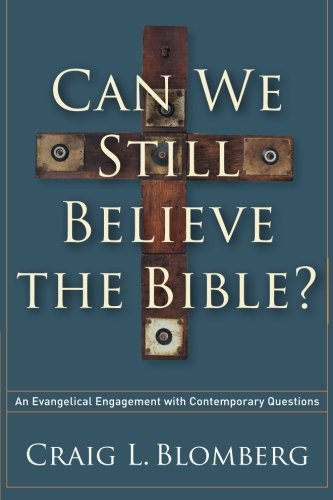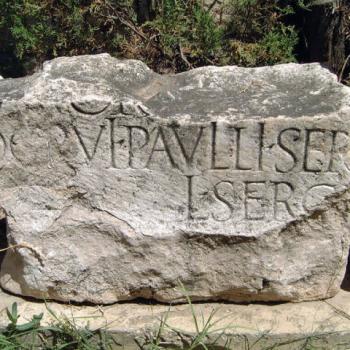Mention the issue of textual criticism and some people think you’re actually talking about criticizing the text of the Bible. Nope. Text criticism is the attempt to reconstruct the earliest form of the Biblical text possible, based on the thousands and thousands of partial and whole manuscripts of various portions of the Bible. In other words, since what we want in our Bibles is the original inspired text plus nothing of what was added later, text criticism is crucial and a positive thing for anyone who really loves the Bible.
Craig Blomberg’s chapter on text criticism is one of the best I’ve found on this subject, not least because it completely lets the air out of the Bart Ehrman balloon in regard to making far too much of textual variants that actually make no difference at all when it comes to essential Christian beliefs, ethics, and practices. He essentially critiques some of things said or implied in Ehrman’s book Misquoting Jesus, a book critiqued in detail previously on this very blog (when it was on Beliefnet.com). Ehrman likes to problematize things, and make them seem far more uncertain than they are.
For instance, as Blomberg points out (pp. 16-17), the claim that there are some 200,000-400,000 textual variants in the some 5,700 manuscripts we have the Greek NT (plus another 10,000 manuscripts of the early Latin versions of the NT). Ehrman then stresses there are more variants than there are words in the NT! You are left with the impression that we can know nothing with real certainty about what the original text of the NT once said. What he fails to tell you is that the 400,000 (probably actually closer to 200,000) variants are spread across 25,000 manuscripts in Greek and other ancient languages. This means there are about 8 variants per manuscript (if the figure 200,000 is closer to the exact number) or 16 if you go with the bigger figure. But that is not all. Most textual variants cluster in places where the text is confusing, difficult, there is prolix grammar, and the like. As Blomberg says, quoting Paul Wegner, the vast majority of textual variants in the NT involve only 10% of the whole text of the NT, and only 6% of the whole text of the OT. Now we have a very very different picture of the situation than was conveyed by Ehrman.
Blomberg’s treatment of the two largest chunks of the NT which are unlikely to have been part of the original inspired text, namely Mk. 16.9ff. and John 7.53-8.11 is both careful and judicious (pp. 18-20). As he points out. There are a larger number of textual variants in these two texts, than one finds elsewhere in these respective Gospels, and for obvious reasons. Scribes kept emending and emending things because these texts were problematic from the outset, and as Blomberg points out Jhn 7.53-8.11 is a text looking for a home—a few mss. place it after John 7.36, or at the end of John. or even after Luke 21.38 or at the end of Luke. Mk. 16.9ff.is missing from most manuscripts of Mark known to Jerome and Eusebius (in the 4th century). As Blomberg stresses, there are no other large chunks of text in those 25,000 manuscripts where this much text is in question. None.
Blomberg takes the time to work through some of the more interesting tendentious textual variants (e.g. the famous Lukan verse about Jesus in the Garden praying with sweat like drops of blood pouring off of him) and as he stresses, most textual variants, indeed the vast majority of them are either: 1) simple copying mistakes (letters read wrong in the original, lines skipped etc.); 2) attempts at improving grammar or syntax in an awkward sentence; 3) the adding of sacred names (e.g. Christ added to Jesus in various places); 4) the adding of clarifying comments. In other words, the vast majority of them neither add nor take away anything essential from the substance or meaning of the text if the issue is major Christian beliefs, practices, or ethics. In other words, while textual variants may not be much ado about nothing, inflated claims about their importance by Ehrman should be ignored! Even when we have a text like 1 John 5, which has later variants which make the text more Trinitarian in character, its not as if there are no references to the Trinity elsewhere in the NT (e.g. in Mt. 28) where the text is not in question at all. No essential Christian belief is hanging by a thread due to textual variants. “The vast majority of textual variants are wholly uninteresting except to specialists” (p. 27). Less than 3% of them are printed in either the Metzger or the Nestle-Aland critical notes to these two major versions of the Greek NT. And in fact Ehrman himself, in a footnote, away from the glaring lights of the main part of his text admits “essential Christian beliefs are not affected by textual variants” (see pp. 27-28 and the notes there).
Another point where Ehrman is misleading is also corrected by Blomberg. As he says, we have 102 mss. of NT books or portions of books from the 2nd and 3rd centuries A.D. Everyone one of them is written with careful handwriting of an experienced scribe, not with the careless scrawl of less literate individuals. What this means is, it is not true that we should expect that the further back we go towards the original manuscript of this or that book, the more textual variants we should expect. This is simply Ehrman, again, trying to make the situation seem more uncertain than it actually is.
Blomberg’s treatment of OT textual issues is equally judicious (see pp. 28ff.). The upshot of this treatment is that what we discovered from close study of the Dead Sea scrolls and other early mss. of the OT in both Hebrew and Greek, is that those medieval Masoretes who provided for us our standard Hebrew text with vowel points (the earliest mss. of which is the Leningrad Codex from the 900s) appear on the whole to have been very conservative copiers of the OT texts they used to produce their editions.
Towards the end of the chapter (pp. 37ff) Blomberg points out the serious textual problems with following a translation like the KJV or to some extent the NKJV which is based largely on the Byzantine text, and the Textus Receptus. Neither of these traditions flawlessly followed the Greek original text as it can be reconstructed today, and so the Greek basis of the translation itself is problematic. The KJV is ultimately based on those thousands of manuscripts copied in Byzantium when it was the capital of Christianity, not based on our earliest and best Greek manuscripts. Let’s be clear that a translation team is only as good as the Greek and Hebrew originals they have before them. The KJV team in the 17th century did a splendid job with what they had, but what they mostly had was late manuscripts from the Byzantine tradition, whereas today we have much earlier evidence of what the original text looked like.
The footnotes are copious in this valuable volume, and should be consulted carefully as well as the text. Craig has done his homework, and I see no major flaws in his argument or flies in his ointment! May it be a balm to you.












